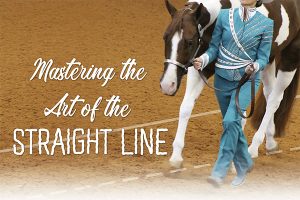Mastering The Art Of The Straight Line
Click here to read the complete article
572 – September/October, 2024
Training your horse to move in a straight line in a showmanship pattern is a fundamental skill that enhances your overall performance and showcases your horse’s precision and discipline. Whether you’re competing in halter or showmanship, mastering this technique is crucial. A straight line indicates control, focus, and effective communication between you and your horse. In this article, we will explore practical tips and techniques to help you and your horse achieve perfectly straight lines, ensuring you stand out in the show ring.
While keeping your horse straight is a fundamental skill, it’s one of the hardest to do.
“Why is it so difficult? The horse tends to want to fall left or right, he doesn’t typically move straight–either drifting gently left or right,” explains AQHA Professional Horseman T.R. Potts. “When you go to lead a horse because he’ll impulse, or push, from behind and step with his shoulder, he’s going to tend to drift off one direction or another.”
After all, horses are either right or left-handed, where they will lean and depend on the right or left side more, says AQHA Professional Horsewoman Shannon McCulloch. “They’ll have weak sides and strong sides.”
And it’s not easy to perform a straight line under saddle, either. Potts, the new University of South Carolina Equestrian Team Coach, explains that it’s easier for a horse to move his body off to one side or another, instead of creating a lift to pick up his weight and the rider’s weight.
“It’s more natural for the horse to be lazy and allow the shoulders to go left or right instead of going straight,” he says. “Under saddle, you have to work with the horse to not go out in the front, but, rather, to lift up and be taller. So, the horse wants to lift in his back and in his neck, while keeping his head down and then stepping straight through the shoulder, so the shoulder doesn’t leak out left or right.”
Fundamentally Forward
Click here to read the complete article
572 – September/October, 2024











